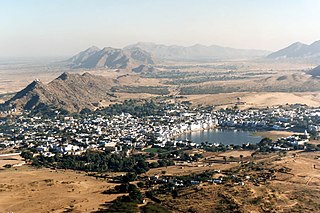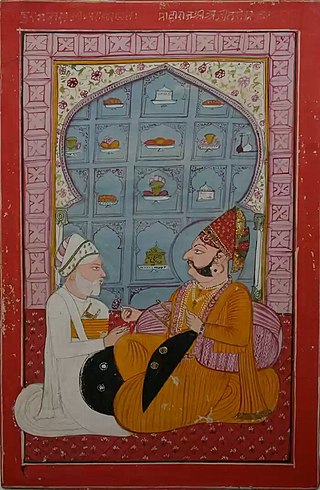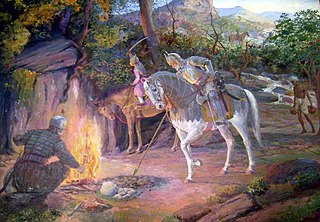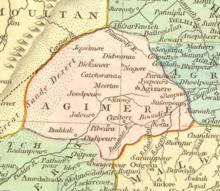
Ajmer is a city in the north-western Indian state of Rajasthan. It serves as the administrative headquarters of the Ajmer district and Ajmer division. It lies at the centre of Rajasthan, earning it the nickname 'the Heart of Rajasthan'.

Pushkar is a temple town near Ajmer City and headquarters of Pushkar tehsil in the Ajmer district in the Indian state of Rajasthan. It is situated about 10 km (6.2 mi) northwest of Ajmer and about 150 kilometres (93 mi) southwest of Jaipur. It is a pilgrimage site for Hindus and Sikhs. Pushkar has many temples. Most of the temples and ghats in Pushkar are from the 18th century and later, because many temples were destroyed during Muslim conquests in the area. Subsequently, the destroyed temples were rebuilt. The most famous among Pushkar temples is the red spired Brahma Temple. It is considered a sacred city by the Hindus particularly in Shaktism, and meat and eggs consumption are forbidden in the city as are alcohol and drugs. Pushkar is located on the shore of Pushkar Lake, which has many ghats where pilgrims bathe. Pushkar is also significant for its Gurdwaras for Guru Nanak and Guru Gobind Singh. One of the bathing ghats is called Gobind ghat built by the Sikhs in the memory of Guru Gobind Singh.

Marwar is a region of western Rajasthan state in North Western India. It lies partly in the Thar Desert. The word 'maru' is Sanskrit for desert. In Rajasthani languages, "wad" means a protected area. English translation of the word 'marwar' is the region protected by desert.

Ajit Singh Rathore was the ruler of Marwar region in the present-day Rajasthan and the son of Jaswant Singh Rathore.

Durgadas Rathore was the Rathore Rajput General of the Kingdom of Marwar. He is credited with having preserved the rule of the Rathore dynasty over Marwar, India, following the death of Maharaja Jaswant Singh in the 17th century. In doing so he had to defy Aurangzeb, a Mughal emperor. He commanded the Rathore forces during the Rajput War (1679–1707) and played a major role in the Rajput Rebellion (1708–1710) and supported the Maratha ruler Sambhaji in the Siege of Janjira aganist the Siddis of Janjira. He was elected as the leader of the revolt along with Raja Jai Singh II of Jaipur. He won a number of victories against the Mughals and forced many Mughal officers to pay tribute to him in the form of chauth.

Rao Maldeo Rathore was a king of the Rathore dynasty, who ruled the kingdom of Marwar in present day state of Rajasthan. Maldeo ascended the throne in 1531 CE, inheriting a small ancestral principality of Rathore's but after a long period of military actions against his neighbours, Maldeo swept significant territories which included parts of present day Rajasthan, Haryana, Uttar Pradesh, Gujarat and Sindh. He refused to ally with either the Sur Empire or the Mughal Empire.
A Subah was the term for a province (state) in the Mughal Empire. The term was also used by other polities of the Indian subcontinent. The word is derived from Arabic and Persian. The governor/ruler of a Subah was known as a subahdar, which later became subedar to refer to an officer in the Indian Army and Pakistan Army. The subahs were established by badshah (emperor) Akbar during his administrative reforms of the years 1572–1580; initially, they numbered 12, but his conquests expanded the number of subahs to 15 by the end of his reign. Subahs were divided into Sarkars, or districts. Sarkars were further divided into Parganas or Mahals. His successors, most notably Aurangzeb, expanded the number of subahs further through their conquests. As the empire began to dissolve in the early 18th century, many subahs became effectively independent or were conquered by the Marathas or the British.

The Kingdom of Amber, also known as Kingdom of Dhundhar, and Jaipur State, was located in the north-eastern historic Dhundhar region of Rajputana and was ruled by the Kachwaha Rajput clan. It was established by Dulha Rai, possibly the last ruler of the Kachchhapaghata dynasty of Gwalior who migrated to Dausa and started his kingdom there with the support of Chahamanas of Shakambhari in the 12th century. Mostly through 12th to 15th century, the kingdom faced stagnation, sources were scarce. Under its ruler, Raja Chandrasen of Amber became a Sisodia vassal and fought in the Battle of Khanwa under Raja Prithviraj Kachhwaha.

The history of human settlement in the western Indian state of Rajasthan dates back to about 100,000 years ago. Around 5000 to 2000 BCE many regions of Rajasthan belonged as the site of the Indus Valley Civilization. Kalibangan is the main Indus site of Rajasthan, here fire altars have been discovered, similar to those found at Lothal.

The Berar Subah was one of the Subahs of the Mughal Empire, the first to be added to the original twelve, in Dakhin from 1596 to 1724. It bordered Golconda, Ahmandagar, Kandesh and Malwa subahs as well as the independent and tributary chiefdoms to the east.

The Kingdom of Mewar, also called Medapata, was an independent kingdom that existed in the Rajputana region of the Indian Subcontinent and later became a dominant state in medieval India. The kingdom was initially founded and ruled by the Guhila dynasty followed by the Sisodiya Dynasty. The earliest kingdom was centered around the south-central part of Rajasthan, state of India. It was bordered by the Aravali Range to the northwest, Ajmer to the north, Gujarat, Vagad and Malwa regions to the south and the Hadoti region to the east.

Kingdom of Marwar, also known as the Jodhpur State under the British, was a kingdom in the Marwar region from 1243 to 1818 and a princely state under British rule from 1818 to 1947. It was established in Pali by Rao Siha, possibly a migrant Gahadavala noble, in 1243. His successors continued to struggle against regional powers for domination and 9 out of 15 rulers till 1438 died in combat. In 1395, its capital was changed to Mandore by Rao Chunda of Mandore and to Jodhpur in 1459 by Rao Jodha.
Ajmer is a historical region in central Rajasthan, a central part of a Shakambari Chahamana (Chauhan) kingdom in 11–12th centuries during the reign of Prithviraj Chauhan.

The Malwa Subah was one of the original twelve Subahs (provinces) of the Mughal Empire, including Gondwana, from 1568-1743. Its seat was Ujjain. It shared borders with the autonomous and tributary chiefdoms in the east, as well as Berar, Kandesh, Ahmadnagar (Deccan), Gujarat, Ajmer, Agra, and Allahabad subahs.
Raja Askaran was a late sixteenth-century Kachwaha Rajput ruler. Though briefly Raja of Amber, for the majority of his life Askaran was the ruler of Narwar. He along with his sons and grandsons also had a distinguished career as military officers and noblemen under Mughal Emperor Akbar and rose high in his service. He was also the maternal grandfather of Manavati Bai of Marwar consort of Emperor Jahangir and mother of Emperor Shah Jahan,hence maternal great grandfather of Shahjahan.

The Agra Subah was a subah of the Mughal Empire, established in the reign of Emperor Akbar and one of the empire's core territories until it was eclipsed by the rapidly expanding Maratha Empire. To the north it bordered Delhi and Awadh, to the east Allahabad, and to the south and west Malwa and Ajmer. Its capital was at Agra, an important administrative center of the empire which was expanded under Mughal rule.
The Battle of Gangwana was a military engagement fought between the Kingdom of Marwar and a combined army of the Jaipur Kingdom and the Mughal Empire in 1741. The battle resulted in a peace treaty favorable to Marwar and ended a period of Jaipur domination in what is now present day Rajasthan.

Bakht Singh or Bakhat Singh was an 18th-century Indian Raja of the Rathore Clan. Born in 1706, he ruled over various domains in the Jodhpur and Marwar states and was a major political force during his life.

Described variously as the Rajput war, Rathore war of independence and Rathore rebellion, the conflict between Rajputs of Marwar and the Mughals started after the death of Jaswant Singh of Marwar, due to Aurangzeb's attempt to interfere in the succession of Marwar. The resistance to Mughal interference was started by the Rajput nobles under Durgadas Rathore and erupted into an all-out war between the Mughal empire and Rajputs of Marwar supported by Mewar Rajputs. It lasted for almost thirty years. The rebellion reached a climax after the death of Aurangzeb on 3 March 1707 and the capture of Jodhpur by the Rathores on 12 March 1707.














